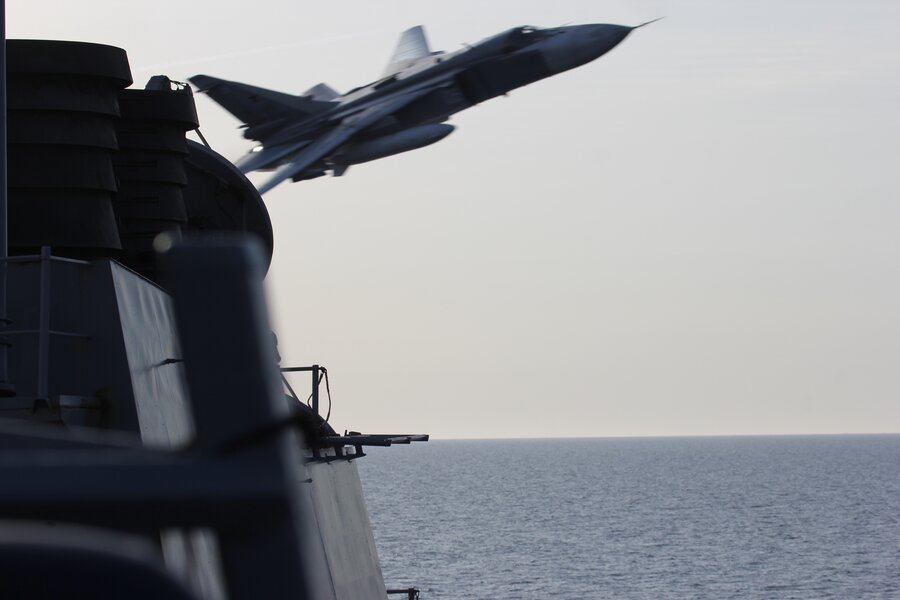Russian jets buzz US ship: Why the White House says it's a big deal
Loading...
Russian warplanes, which appeared to have been unarmed, flew dangerously close to a US Navy destroyer in the Baltic Sea earlier this week, the White House confirmed Wednesday.
Pentagon officials believe the Russians' flybys, which the USS Donald Cook's commander called a "simulated attack," intended to send a message: they clearly dislike the destroyer's proximity to Russia, located 70 miles off its coast.
Russian officials defended the flybys on Thursday. "To be honest, we don't understand such a painful reaction from our American colleagues," Maj. Gen. Igor Konashenkov, a Russian Ministry of Defense spokesman, said in a statement.
All Russian military flights are "conducted in strict compliance to the international rules of airspace management over neutral waters," Major General Konashenkov said.
But the White House disagrees, arguing that the jets' 31 flyovers over a span of two days were anything but commonplace.
"This incident ... is entirely inconsistent with the professional norms of militaries operating in proximity to each other in international waters and international airspace," White House press secretary Josh Earnest said Wednesday. "Any peacetime military activity must be consistent with international law and norms, and conducted with due regard for the rights of other nations."
According to the United Nations, every State can only lay territorial claim to waters within 12 nautical miles of their country's coast – meaning the USS Cook was in international waters.
"They're playing with fire here," Evelyn Farkas, a former Russian policy expert for the Pentagon, told CBS News. "I'm sure that U.S. ships and other non-Russian ships have been just as close in the past. And even if they haven't, again, they're in international waters; there’s nothing provocative about what we're doing. Unlike the Russians, we actually telegraph very transparently what we’re doing."
This isn't the first time that Russian military aircraft has broken the international status quo.
"There have been repeated incidents over the last year where the Russian military, including Russian military aircraft, have come close enough to each other or have come close enough to other air and sea traffic to raise serious safety concerns, and we continue to be concerned about this behavior," Earnest told reporters on Wednesday.
An almost identical situation occurred about two years ago to the day: Russian aircraft flew within 1,000 yards of the same ship in a move Pentagon officials decried as "provocative," although the dozen passes did not fly over the USS Donald Cook directly.
During the Cold War, these sorts of flybys "happened all the time," Christopher Harmer, a retired Navy officer who served as deputy director of future operations for the US Navy's Fifth Fleet, told The Monitor’s Anna Mulrine in April 2014:
We used to call it the "standard harassment package," and it was meant to send a message. It was their way of saying, "We the Russian military are still capable of monitoring the US Navy and still capable of putting ourselves in a position to harm you if it comes to that."
Last year, another similar incident occurred when Russian jets buzzed the US Navy's USS Ross while on patrol in the Black Sea.
But just as the US ship had a right to be in those waters, the Russian jet had a right to be in the air, Konashenkov argued Thursday.
"The principle of freedom of navigation for the US destroyer, which is staying in close proximity to a Russian navel base in the Baltic Sea, does at all not cancel the principle of freedom of flight for Russian aircraft," he said, according to CBS.








